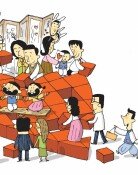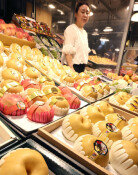The inflation battle is far from over
The inflation battle is far from over
Posted August. 24, 2024 07:30,
Updated August. 24, 2024 07:30
"26,000 won for this?" That was my reaction recently when I ordered a salad at a family restaurant in Gwanghwamun, Seoul. Given the price, I expected a generous portion, but I was stunned by how small it was. After spending years in New York—infamous for its sky-high prices—I thought I was prepared for anything. But the Seoul I returned to after three years is proving to be just as challenging.
The cost of fruits and vegetables is particularly alarming. I’ve found myself double-checking prices in disbelief. Recently, a doctor in an online diet video advised viewers to wrap their meat in several layers of lettuce. The comment section quickly became a forum for people venting about high prices, with some saying, "Lettuce in layers is a luxury." Last month’s heavy rains caused lettuce prices to soar by over 170%.
The disconnect between what we feel in our wallets and the official inflation rate is stark. In truth, inflation, aside from certain vegetables, has stabilized. On Thursday, Bank of Korea Governor Rhee Chang-yong remarked, "We are increasingly confident that inflation is converging toward our target level." While rising housing prices have kept interest rates high, inflation itself is said to be under control. Even the U.S. Federal Reserve, which rattled the world with its aggressive rate hikes, is preparing to declare victory in the war on inflation and may soon lower rates.
But despite these assurances from central banks, the everyday reality for most people is that the struggle with inflation is far from over. When prices have already skyrocketed, even a low inflation rate feels oppressive. There’s a psychological threshold when it comes to prices. Once prices for "5,000 won coffee," "10,000 won cold noodles," or "20,000 won pasta" are breached, consumer resistance intensifies. High inflation erodes our ability to maintain our standard of living, and as the cost of living becomes overwhelming, the real pain grows. Moreover, after prolonged high-interest rate policies, an economic slowdown is on the horizon. The fallout from this "cost of living crisis," driven by both high inflation and high-interest rates, will likely linger longer and cut deeper than any official statistics can capture.
Whenever public sentiment turns sour over the economy, populism is never far behind. In the tight U.S. presidential race, price controls on food companies have become a hot topic. Kamala Harris, gaining traction as the Democratic candidate, has made her first economic pledge to outlaw "price gouging." This promise was made in response to widespread public anger over inflation. However, drawing a legal line between corporate greed and reasonable profits is nearly impossible. Price controls often lead to lower-quality products and services or reduce market participation, ultimately causing prices to surge even higher. Successful examples of price control are few and far between for a reason.
Politicians likely understand this, but short-term electoral gains seem to matter more. We don’t have to look far for a similar example. Here in Korea, the main opposition Democratic Party of Korea is pushing a policy to distribute 250,000 won to every citizen. Have we forgotten the inflationary storm that arose when governments around the world flooded the market with money during the pandemic, stimulating demand in a constrained supply environment? The same policies that contributed to high inflation and interest rates cannot be repackaged as solutions to those very problems. In the end, addressing inflation, though it may take time, can only be achieved by restoring the balance between supply and demand. Factors like climate change, war, and trade barriers mean that high inflation is already a long-term challenge. As the economy slows further and the cost of living crisis deepens, resisting the lure of populist quick fixes will be the first and most crucial step in crafting a real solution to inflation.
Headline News
- Shin Hanul 3 and 4 nuclear power plant construction resumes
- Political leaders and doctors struggle to convene a council
- Trump sparks debate with false claims, Harris criticized for job numbers exaggeration
- Money Lending Act amendment bill to begin this month
- Washington puts pressure on Seoul to join chips regulations on Beijing







